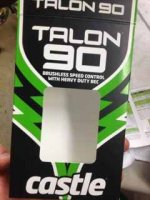Anthony7820
70cc twin V2
Anthony,
Patrick del Castillo (the owner, head engineer and CEO of the company) has responded directly to these concerns on the RC Groups forum. Here is his response:
"Here's the answer from James Anderson -- our engineer in Kansas who did the testing on the single RX lead version of the Beta Talon-90.
This was originally posted in Castle Creations' Beta testing forum.
"We have done extensive testing with the Talon BEC using resistive loads, as well as power hungry align, savox, and several other normal and HV servos. The current that is drawn by servos is very inconsistent and will normal be very low (under 2A) with large spikes (~5A) during fast movements. During testing we kept the servos moving as much as possible and watched the temperatures of the wires and connectors using a thermal camera. Even under resistive loads higher than our continuous rating the connector temperature never reached unsafe temperatures. Our testing left us confident that a single connector and wire will be able to handle the loads of any setup.
A second servo lead was considered as a way to give the consumer piece of mind but was decided against to maintain the simplicity of the product. A second lead may lead to confusion with people new to the hobby and would also likely lead to support issues during castle linking. The castle link adapter is only able to provide power to the unit during programing. With a second wire the second wire would have to be disconnected from the servos and radios to castle link or extra circuitry would have to be added leading to more cost as well as inefficiency. The BEC pro has a separate link port for this reason. This could be done on the Talon as well but adds even more complexity and cost to the unit.
The goal of this unit was to make a simple lower cost product that is easy to setup. Because of the problems mentioned above it was decided that a second wire would not be a step towards this goal. Our testing has showed that the single wire and connector will be safe for even the toughest setup. Since we have received a good amount of feedback asking about a second wire I will make sure that it is considered again when we work on future projects.
We do not recommend soldering a second servo lead to the unit. The case was not designed to support this and it will likely lead to wire chafing.""
Here is Castle's answer to the one servo wire.

